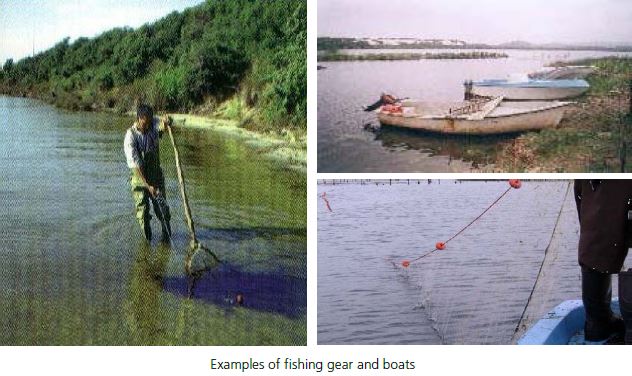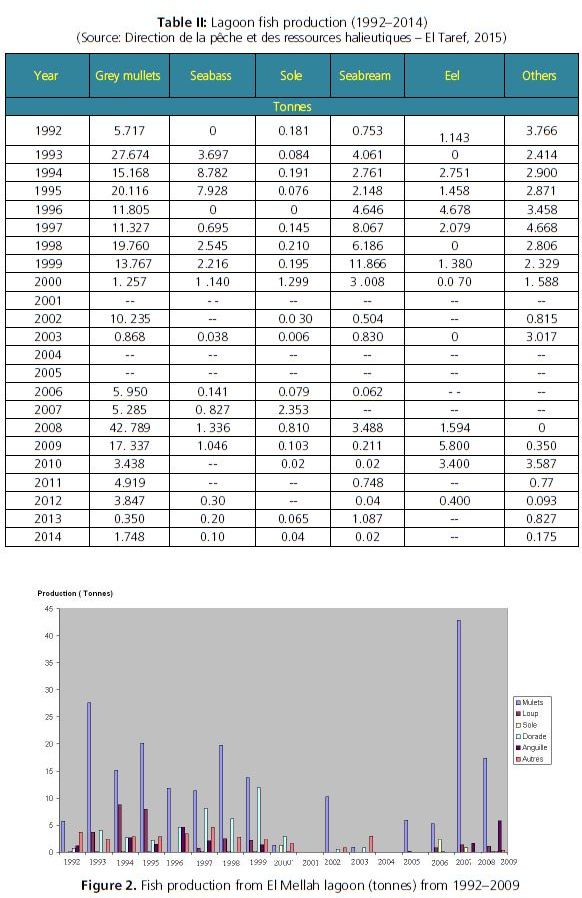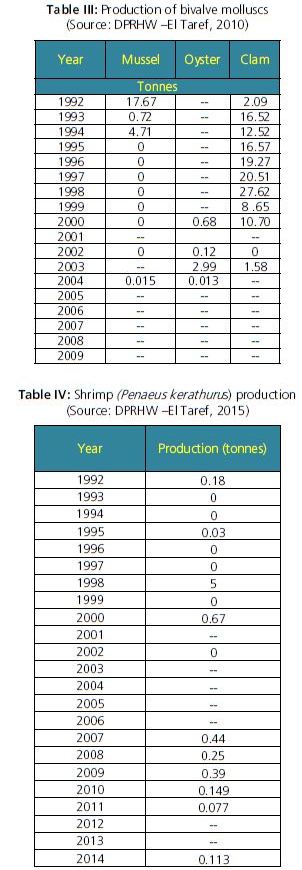2.4 Lagoon exploitation
2.4.1 Aquaculture and capture fisheries
Fishing gear
The activity of fishing of fish and shellfish in lake Mellah is practised by means of various fishing gear: fish wiers (bordigue), gillnets and bow nets for fish, rakes for the digger shells (clams).
Fish wiers: The bordigue is an installation that allows the capture of the euryhaline species in their migratory phase. This system of trapping does not represent only one capture device, but also a tool to prevent fish from migrating back to sea. The bordigue in Mellah was built around 1920 and has been used ever since.

Algerian bordigues
Mono-twine nets: The mono-twine net consists of only one cloth, maintained on the surface by a rope of floats and ballasted by lead to its lower part. It is composed of several pieces 50 m long attached one to the another, forming a net of 200 (four pieces) to 350 m (seven pieces) long. With a mesh size from 3.2 to 4 cm.
Trammel nets: Trammel nets are made of three juxtaposed nappes; the two external ones have large mesh size (10 cm), the intermediate nappes have small mesh size (2.5 m). It is 300 m long on average (six pieces of 50 m) and from 3 to 5 m high, and it is placed in the coastal belt (in particular near the nappes) because of the lack of oxygen in the central zone (especially in summer). Once fixed, this net forms a vertically maintained wall.
Fyke nets (or verveux): This capture gear, of artisanal manufacture (circles made of wood, plastic, metal or net), is generally intended for fishing of the sedentary and benthic species. In lake Mellah, it is composed of three capture chambers in the form of large conical pockets. Each pocket is divided into compartments communicating between themselves by a small opening. Fixed firmly to the bottom, the water current cross-piece from the beginning to the end.
Clam harvest is related to primarily clam and constitutes an artisanal activity, as in the majority of the areas where it is the subject of an exploitation. The exploitation is centered on two principal zones, Is and the south of the lake. Two fishing techniques are used:
• Manual harvest: it is the most currently used but also the most selective; the fishers wear a waterproof waterleg and the clams are collected by hand and at very low depths not exceeding 1m. They are located at sight at naked eye thanks to the small holes which appear on the surface of the sediment and which correspond to the inhale and exhale siphons of the individuals.
• Fishing with the clovissiere: it is a rake with teeth, provided with a small net 2 cm mesh size and with a handle of approximately 2 m long (see below). It is used in the zones where manual gathering is impossible (1 to 1.5 m depth). When the depth is more significant (2 to 3 m) this gear is used with a small boat.

Boats: There are 6–10 meters long fishing boats with 25 CV outboard engines.
Examples of fishing gear and boats
The principal species captured in the lagoon are grey mullets, European seabass, gilthead 8
seabream, eel, white bream and shrimp.
Aquaculture facilities
There was an aquaculture farm in the El Mellah lagoon with facilities located at the northern end of the lake in the zone of the beginning of the channel. They were mainly annexes and cold rooms near a storeroom, which were built to shelter a hatchery and concrete tanks for the pre fattening and the grow-out of the culture products. But the hatchery was never built and the facilities are not used anymore, and are currently in rather bad conditions.
In the middle of the channel and vis-a-vis the mouth of the Oued Bou Hadjl, there were facilities for shellfish culture similar to those found in the Thau lagoon (France). The mussels and the oysters produced in the lagoon are introduced species. They were grown on shellfish culture installations on tables, set up on the bottom 2.5 to 3 m deep in the northern zone of the lagoon. These supports are of traditional type, made of iron poles (railroad rails), inserted vertically and separated 2.5 to 3 m apart. These systems have the advantage of being very robust and require little maintenance. There has been no shellfish producion since 2004.
There is no specific management plan for the coastal lagoon of El Mellah.
Eels are exported directly to Italy. The transport of aquaculture products is ensured by isothermal trucks.
Currently eels are not exported in case of standards for export given that the European regulations require that lakes should have a management plan.
Regarding of this, The Ministry of Fishing and Fisheries Resources will soon launch a study determining the biomass of eel and development of a management plan.
Table II: Lagoon fish production (1992–2014)
(Source: Direction de la peche et des ressources halieutiques – El Taref, 2015)

Figure 2. Fish production from El Mellah lagoon (tonnes) from 1992–2009
Table III: Production of bivalve molluscs
(Source: DPRHW –El Taref, 2010)
Table IV: Shrimp (Penaeus kerathurus) production
(Source: DPRHW –El Taref, 2015)

2.5 References
Central Intelligence Agency (CIA). 2012. The CIA world factbook [online]. Washington, DC. [Cited 26 April 2012]. www.cia.gov/library/publications/the-world
factbook/geos/ag.html.
Boumezbeur, A. 2002. Atlas des 26 zones humides algeriennes d’importance internationale. Ben Aknoun, Alger, Algeria, Direction generale des forets.
Moussi, N. 2012. National Aquaculture Sector Overview–Algeria. In: FAO Fisheries and Aquaculture Department [online]. Rome. [Cited 20 April 2012].
www.fao.org/fishery/countrysector/naso_algeria/en
Ministere de l’agriculture et du developpement rural (MADR). 2004. Atlas des 26 zones humides algeriennes d’importance internationale. Ben Aknoun, Alger, Algeria, Direction generale des forets.
Ministere de l’agriculture et du developpement rural (MADR). 2005. Parcs nationaux d’Algerie. Alger, Algeria, Direction generale des forets.
Ministere de la peche et des ressources halieutiques (MRRH). 2010. Index referentiel des textes legislatifs et reglementaires–Peche et Aquaculture. Alger, Algeria.
Ministere de la peche et des ressources halieutiques (MRRH). 2011. Statistiques des peches. Alger, Algeria.
Office national developpement et protection aquacole, Spa (ONDPA). 2003. Etude portant sur la connaissance des biomasses des lacs de la wilaya d’El Tarf et etablissement des regles de gestion halieutique specifique Tome I, Tome II. Alger, Algeria.
SIPAM. 2012. SIPAM [online]. Rome. [Cited 26 April 2012]. www.faosipam.org 71